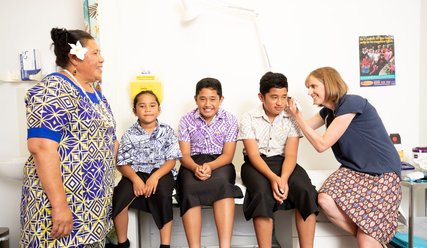Prioritising Māori and Pasifika for vaccination will save lives
By Dr Maia Melbourne-Wilcox (FRNZCGP), Professor Sue Crengle (FRNZCGP), Alex Bygrave (RNZCGP Communications Advisor), in collaboration with the RNZCGP Pasifika Chapter
13 September 2022
Category: Equity
Share
Staying in our bubbles did more than slow the progression of COVID-19 in our community. For the past two years, pandemic measures have prevented Aotearoa’s usual flu season. However, with international borders now open, COVID-19 restrictions easing and changes in infection control behaviours, that reprieve is now well and truly over. We are currently facing the challenging combination of COVID-19 and influenza circulating side by side in our communities, and our health system and health workforce are feeling the strain.
In a typical year, influenza accounts for one-two percent of all deaths in Aotearoa1. Influenza is again circulating in the community and is already spreading quickly in some areas of the South Island. After two winters without influenza, experts are concerned that nationwide immunity against the flu is lower than usual, resulting in the higher risk of serious illness, hospitalisation, and death as a result.
Māori and Pasifika populations have previously been shown to be at much greater risk of dying prematurely from the flu, with Māori being 3.6 times more likely than non-Māori, and Pasifika being 2.4 times more likely than non-Pasifika, to die due to the flu in a normal flu season1.
The statistics tell a similar story about COVID-19 inequity. Māori are 2.5 times more likely, and Pasifika are 3.06 more likely, to be hospitalised for COVID-19 (Styn 2021 NZMJ). A summary of data from the Ministry of Health shows that Māori and Pasifika people combined, have made up 28 percent of positive COVID-19 cases in New Zealand so far, but disproportionally make up 49 percent of hospitalisations due to COVID-19. Māori and Pasifika are over-represented in known cases of COVID-19, but also likely under-counted, as these populations face additional barriers to care and to COVID-19 testing.
This excess burden of disease is the result of inequities in the social determinants of health, such as poor quality and crowded housing, as well as higher prevalence of conditions that increase risk of adverse outcomes (e.g pre-existing respiratory conditions) that occur at younger ages in the Māori and Pacific population compared to other populations.
Profound inequities are seen in both COVID-19 death and hospitalisation rates of younger age groups. Current data shows that Māori and Pasifika people under 59 years make up 58.6 percent of deaths within 28 days of COVID-19 infection (Māori: 41.4 percent, Pasifika: 17.2 percent). (MOH) Māori people aged 44.3 years and Pasifika people aged 39.8 years demonstrate the same risk of hospitalisation as a result of COVID-19 infection as non-Māori non-Pacific aged 65 years. (Styn 2021 NZMJ)
Supporting our health system with vaccination
Preventing unnecessary complications and hospitalisation from both COVID-19 and influenza is urgent this year, with our entire health system already struggling with staff illness, burnout and limited appointments and space to review all those who are unwell.
The best way to minimise additional burden on our already stretched system is by ensuring those most at-risk of flu and COVID-19, particularly those that are likely to experience more severe illness, complications, or hospitalisation should receive flu vaccines and COVID-19 boosters as a matter of urgent priority. Māori and Pasifika people experience inequitable health outcomes including a higher burden of the disease and higher rates of associated complications2. This results in requiring additional medical reviews and hospitalisations.
Flu vaccination
Annual flu vaccines have traditionally been our best method of preventing the flu and have been shown to reduce rates of hospitalisation and those suffering flu-related complications2. Our health system is yet to deliver influenza vaccination equitably to Māori and Pasifika populations. With rates of flu vaccination for eligible Māori and Pacific populations, historically being much lower compared to other eligible populations2.. There is clearly evidence of worse outcomes for these groups, where vaccinations are not fully funded.
This year PHARMAC has introduced an age-based criteria for Māori and Pasifika populations with the influenza vaccine, which they have described as a proactive move to help address existing health system inequities. This means that for the first time, all Māori and Pasifika who are 55 years or older, are eligible to receive a fully funded influenza vaccine. Clinical experts see the widening of access to the influenza vaccine as a positive step in the right direction.
PHARMAC have also widened criteria for funded flu vaccination to include 3 - 12 year olds, and those with schizophrenia, major depressive disorder, bipolar disorder, schizoaffective disorder or anyone currently accessing secondary or tertiary mental health and addiction services.
Fully funded high risk groups for flu vaccination include:
- Māori and Pasifika over 55 years with or without co-morbid conditions.
- Māori and Pasifika who are pregnant.
- Māori and Pasifika children under 12 years old.
- Māori and Pasifika with serious mental health conditions such as schizophrenia, major depressive disorder, bipolar disorder, schizoaffective disorder or that are currently accessing secondary or tertiary mental health and addiction services.
- Māori and Pasifika with particular comorbid conditions. View the full list of conditions.
Non-Funded high-risk groups for flu vaccination include:
- Māori and Pasifika children younger than three.
- Māori and Pasifika who are quintile four and five and those living in poor quality housing and overcrowded conditions.
- Anyone whose ability to adequately protect themselves against infective conditions may be limited by their situation (e.g. homelessness, cognitive disorder etc).
- Note: While these groups are not currently funded, GPs should still identify and offer flu vaccinations to these groups when able, as these groups still experience inequitable outcomes and complications with influenza.
COVID-19 vaccinations and boosters
Alongside the seasonal flu vaccination, priority should be given to keeping the most vulnerable populations up to date with their COVID-19 vaccinations, including any boosters that become available. From 1 July, second COVID-19 boosters are available six months after the first booster (or three months following COVID-19 infection) for those at risk of severe illness from COVID-19.
Priority for COVID-19 booster vaccinations should be given to these groups:
- Māori and Pacific peoples aged 50 years and over.
- Māori and Pacific residents of aged care and disability care facilities.
- Māori and Pacific people who are severely immunocompromised, who received a three-dose primary course and a fourth dose as a first booster (noting this would be a fifth dose for these people).
- Māori and Pacific people aged 16 years and over who have a medical condition that increases the risk of severe breakthrough COVID-19 illness.
- Māori and Pacific people aged 16 years and over who live with disability with significant or complex health needs or multiple comorbidities.
- Māori and Pacific health, aged care and disability workers aged over 30 years.
Standard practice in primary care, often uses a combination of recall systems to trigger patient reminders and opportunistic vaccinations during in-person consultations. However, this approach ignores the existing barriers to care that some of our patients experience and contributes to our inequitable vaccination rates. Evidence has shown that the strongest single factor influencing patient uptake of the vaccination is a personalised, specific recommendation from a doctor or nurse.3
Standard generic reminders will not likely be effective enough to reach those most at-risk. Instead, specific, and targeted measures will need to be taken in order to vaccinate our most vulnerable populations1. This will have the benefit of trying to protect the health of the most vulnerable and their families - and to help prevent additional preventable pressures being placed on our health system later, when it may be most needed.
Principles for primary care
Offer eligible Māori and Pasifika patients their COVID-19 booster vaccination at the same time as their flu vaccination.
Identify and specifically target priority groups. Focus should be on those who experience the most barriers to care AND those who are at highest risk of mortality and would require medical attention in the future if they were to contract influenza.
- Send out welcoming automated texts to these patient groups. Incorporate saying hello in their language. For example, ‘Kia ora, It’s really important to get a flu vaccine this year, to protect you and your whānau. It’s here now and free for you and all tamariki 3-12yrs. Please phone us to make a time to come in.
- Remember that there will be people in the community without phone credit to ring you.
- Follow up with a phone call these patients if they do not respond within one week. Dedicate a clinical staff member to call these patients to discuss their need for the flu vaccine/COVID-19 booster vaccinations and how it can have benefits for both them and their whānau. Personal contact allows an opportunity to relay the importance and allay any fears, misinformation or hesitation3.
Talk about the importance of flu vaccination and offer opportunistic vaccine during every phone, virtual and in-person consultation with Māori and Pasifika patients.
Keep some vaccinations aside for the opportunistic vaccination of Māori and Pasifika patients who may be less able to return due to barriers outside of their control
** Evidence of a commitment to equitable health outcomes could be submitted towards your practice’s equity module requirements.
In addition:
- Egg allergies: The types of flu vaccine given in 2022 can be given to people with egg allergies.
- Latex allergies: None of the flu vaccines used in 2022 have come into contact with any latex materials, and the syringes do not have any components made using natural rubber latex.
References:
- Styn,N, et al. (2021) Māori and Pacific people in New Zealand have a higher risk of hospitalisation for COVID-19. NZMJ July 221,Vol134 No 1548 pp28-53.
- (Paper around delta outbreak) https://assets-global.website-files.com/5e332a62c703f653182faf47/60e6167dc6a453d0e48e553c_5049%20-%20final.pdf
- From MOH accessed today 2nd June. https://www.health.govt.nz/covid-19-novel-coronavirus/covid-19-data-and-statistics/covid-19-case-demographics#aug-2021


